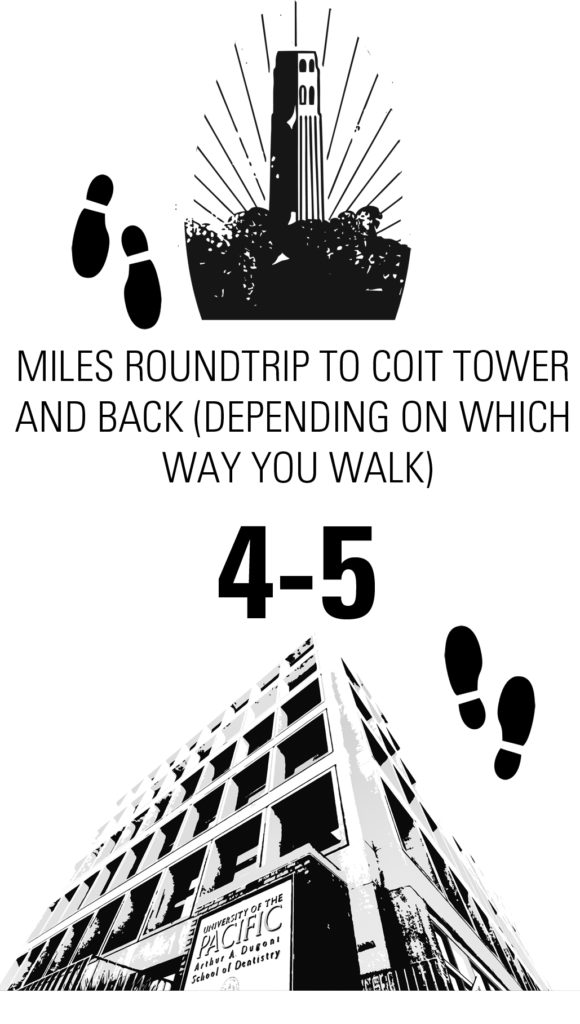By Christina Boufis
“Thirty-three percent of Americans today are considered obese,” says Dr. Marc Geissberger ’91, professor and chair of the Department of Integrated Reconstructive Dental Sciences, “and obesity leads to other health issues—such as cardiovascular disease and diabetes.” Indeed, nearly 26 million children and adults in the United States have diabetes—8.3% of the population—according to the American Diabetes Association, at a cost of $174 billion annually. What’s more, seven million more people have undiagnosed diabetes, a major cause of heart disease and stroke and the seventh leading cause of death in the United States.
Fortunately, the dental school is working to change these statistics for its faculty, staff, students and even the surrounding neighborhood. In 2009, the school first participated in Active for Life, an American Cancer Society program, with the goal of encouraging fitness in a team setting. “It was pretty successful,” says Armando Ortega, human resources representative. “We had a lot of friendly competition, and that began a snowball effect to create a committee here that would continuously offer programs for physical and mental health and nutritional resources.” Thus the Health and Wellness Committee was born.
One of their first initiatives? The committee decided to replace unhealthy options in the vending machines with more nutritious choices. “Our vending machines were full of sugary items, and there weren’t many options,” explains Ortega, the committee’s first chairperson. Today, gone are many of the high-fat, high-salt content snacks, replaced by things such as coconut water, fat-free cookies, baked edamame, vegan brownies and almonds. “We still have fried chips and candy bars,” explains Ortega, “but people can make their own decisions,” to choose healthy snacks.
In addition, the committee has worked to offer better food choices in Café Cagnone, such as a salad bar, and is looking into increasing the number of nutritious choices, perhaps adding more fruit and vegetables to confirm the commitment to increasing healthy options, says Ortega.
Faculty, staff and students have access to healthier food choices outside the building as well. In September 2010, the dental school held its first farmers’ market with two vendors offering organic produce and farm-fresh fruit. The idea was the brainchild of Katherine Falk, web communications specialist, who noticed that some hospitals, such as Kaiser, offer farmers’ markets at their sites. “We’re a dental school, and we’re always talking about the connection between oral health and overall health. Why not connect the dots and be one of the first dental schools to offer a farmers’ market?” she asked. Not only were there no easily accessible farmers’ markets nearby but also there was an underutilized space, says Falk: the first-floor plaza.
“We think of ourselves as the Dugoni family,” says Falk. “My hope was that if people come out to the plaza, they might linger and talk, and colleagues from different floors might run into each other,” she explains. “On nice days, that’s how it works.”
[pullquote]“We’re a dental school, [and] we’re always talking about the connection between oral health and overall health. Why not connect the dots and be one of the first dental schools to offer a farmers’ market?” —Katherine Falk[/pullquote]
Falk says she and her colleagues often share recipes or rave about the seasonal produce, such as fresh green peas or beans. “It’s great to be able to go downstairs and pick up my vegetables for the week,” says Falk. Another added benefit? The price. “There’s still this misconception that farmer’s markets are expensive,” says Falk. “And they’re really not. I would often go to the veggie stand and find it was cheaper than the chain stores—and it tastes much better.”
The farmers’ market runs every Wednesday 11:00 a.m. to 2:00 p.m. from early spring through late fall, and Falk says they’d like to increase their vendors, perhaps adding a baked goods stand. “By improving people’s access to good produce, their diets get a little healthier and maybe their bodies get a little healthier too,” adds Falk.
Eating a balanced diet, including lots of fruits and vegetables, can improve oral health and reduce the risk of gum disease, according to the Academy of General Dentistry. “Right now there’s overwhelming evidence in all the medical and dental literature that really connects the health of the mouth to the rest of the body,” says Geissberger. “One example is that people with gum disease are at higher risk for cardiovascular disease.”
To foster awareness of this connection, the Health and Wellness Committee began hosting lunch and learn sessions last year—hour-long programs open to the entire community on health topics. Sessions have included registered nutritionists speaking about nutritional packaging labels and planning healthy menus; yoga instructors introducing the benefits of practicing yoga; acupuncturists lecturing on traditional Chinese medicine and registered nurses raising diabetes awareness. “We’ve also had faculty talk about oral cancers and how to take preventive measures against cancer and other diseases as well,” says Ortega.
[pullquote]“When we’re considering programs, we look at giving everyone the ability to try something new—something they might not have done in the past,” says Ortega.[/pullquote]
In addition to the educational lunch-and-learn programs, the Health and Wellness Committee also offers activity-based programs as well. For instance, they just presented an eight-week tai chi series, says Marco Castellanos, financial aid director and Health and Wellness Committee member who participated in the tai chi series. “It was my first time doing it,” says Castellanos. “The instructor provided us with the benefits of tai chi and taught us an introduction to the form and how to relax and de-stress. I think it was beneficial for my overall health,” he adds.
Indeed, one of the Health and Wellness Committee’s goals is to introduce new ideas for health, wellness and physical fitness. Tai chi might be rotated with an eight-week introduction to yoga or even meditation. “When we’re considering programs, we look at giving everyone the ability to try something new—something they might not have done in the past,” says Ortega.
Another Health and Wellness Committee offering is the weekly Thursday walk, a four- to five-mile, round-trip walk to Coit Tower. One of the ways that the committee knows it is successful is the feedback it receives from participants. Often long after a program has ended, committee members get comments from a faculty member, staff member or student who will say, “‘When I go home after work, I go running now, which I never did before. Or, ‘I walk more, and I’ve lost 30 pounds,’” recounts Ortega.
And people recognize informational e-mails with the Health and Wellness Committee logo, says Castellanos. “They know it has something to do with an activity or event. We’re making sure health and wellness is going to be sustained for a long time and that it becomes part of the culture of the University.”
Perhaps the most popular Health and Wellness offering is the Boot Camp, run by Geissberger, who in addition to being a faculty member and department chair is also a certified personal trainer. The weekly, hour-long session combines cardiovascular training and balance and weight training. “It’s pretty intense,” admits Geissberger. “And it burns about 600 to 800 calories an hour.”
[pullquote]Though he jokes that he gets a lot of hate e-mail, with participants writing that he killed them in Boot Camp, “It’s really a lot of fun,” adds Geissberger.[/pullquote]
The Boot Camp, which is held in the school’s cafe and is open to everyone at the dental school, is comprised of an even mixture of students, faculty and staff, with the youngest participants in their 20s and the oldest in their 70s. “We’re all on a first-name basis,” says Geissberger.
The class is tailored to each participant so that everyone can meet individual goals, whether that’s weight loss or replacing body fat with muscle. “I always give them three variations on every exercise—beginning, intermediate and advanced—so everybody is working the same muscle group but at different intensity levels,” says Geissberger.
But there is one rule that everyone must adhere to: you can’t say, “I can’t do that,” in response to an exercise. “If I say, ‘Drop down, and give me 10 pushups,’” says Geissberger, “the only responses are either, ‘Yes,’ or ‘I don’t know if I can, but I’m going to try.’” And “people always surprise themselves,” he adds, by being able to accomplish more than they thought they could.
Geissberger can recount numerous examples of boot camp participants who first came to the class unable to do a single modified push-up but after several weeks could do 30 or more advanced push-ups. Many others have dropped more than 20 pounds. Yet besides losing weight, the goal is to be physically fit, says Geissberger. “The focus first is to get people healthy; but healthy just means you don’t currently have any diseases. People who are physically fit are beyond healthy. There’s a lot of evidence now that people who stay physically fit, ward off disease processes as they age,” he explains.
And though he jokes that he gets a lot of hate email, with participants writing that he killed them in Boot Camp, “It’s really a lot of fun,” adds Geissberger.
Perhaps what sets the dental school apart is the variety and number of wellness offerings—promoting everything from biking to work to Boot Camp. “I haven’t heard of other dental schools going to this extent,” says Ortega. “Our focus is providing a top education in oral health. Good oral health contributes to overall good health. And the Health and Wellness Committee [offerings] go hand in hand with our school’s vision.”
Christina Boufis, PhD, is a freelance health and medical writer from the East Bay.
Farmers Market Reopens April 18!
The farmers market you read about just now will be starting back up Wednesday, April 18, 2012, and will be happening every week from 11 am to 2 pm. Click the video below to watch a recap of our very first day in action back in 2010.


